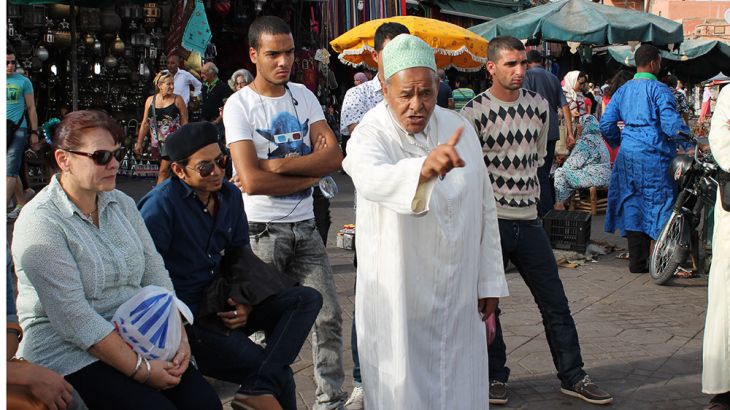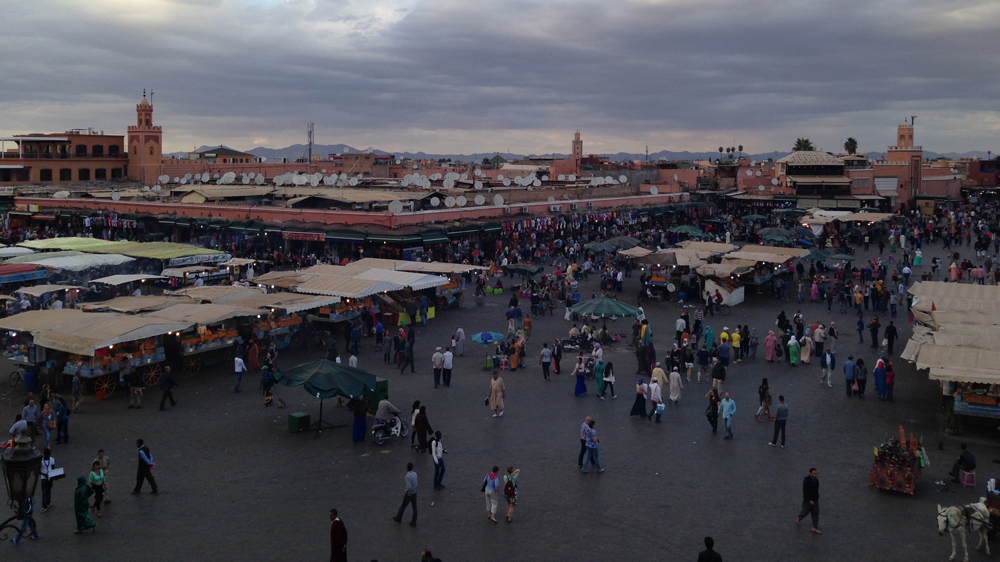
A Marrakech Tale
Master storyteller Ahmed Ezzarghani and apprentice Sara are fighting to keep the Moroccan storytelling tradition alive.
Oral storytelling has been an integral part of Moroccan culture for over a thousand years. But now the precious art form is disappearing, due to the availability of new forms of entertainment through modern technology.
Hajj Ahmed Ezzarghani has been telling stories for over five decades. Now in his 70s, the master storyteller has retired from the chaos of Marrakech’s famous square, Jemaa el-Fna. He finds new purpose in teaching young apprentices the skills of the ancient art form.
Keep reading
list of 4 itemsUK returns looted Ghana artefacts on loan after 150 years
Fire engulfs iconic stock exchange building in Denmark’s Copenhagen
Inside the pressures facing Quebec’s billion-dollar maple syrup industry
Novice storyteller, Sara Mouhyeddine, dreams of eventually performing in Jemaa el-Fna but soon realises it might be easier said than done in a space traditionally dominated by male performers.
To stand a chance at being able to publicly showcase her skills, Sara must win the approval of Hajj.
As one of a handful of storytellers left in Morocco, Hajj knows it is now up to Sara’s generation to save these precious stories, passed down through generations, before it is too late.
FILMMAKER’S VIEW
By Horia El Hadad
I had read that Morocco was one of the last places in the Arab world where storytelling still existed as entertainment. It was obvious then that our search for a “master storyteller'” or Hakawati , would lead us to Marrakech’s famous Jemaa el-Fna square, Morocco’s biggest open air theatre.
“There are no more Hakawatis left here! Now they’re all either too old or dead,” said Hajj Ahmed Ezzarghani, a master storyteller, who retired from the square in 2009.
Sitting across from me on the roof terrace of Jemaa el-Fna’s popular Restaurant Les Premices, Hajj slowly sipped his espresso while observing the chaos below.
 |
| Hajj spent the majority of his time performing in Marrakech’s iconic Jemaa el-Fna square [Al Jazeera] |
Wearing a yellow turban, long white robe, leather satchel and slippers, Hajj conjures up the archetype of a master storyteller – a man who has dedicated his life to memorising and relaying hundreds of stories, typically involving powerful kings, scheming sorcerers or cunning thieves.
Before retiring, Hajj spent over five decades performing in public squares around Morocco, wandering from the bustling port cities of the north to the sleepy towns and villages in the south. But it was Jemaa el-Fna where Hajj spent the last few years of his storytelling career.
Hajj tells me he was eventually driven out by younger performers, who would sabotage storytelling circles with loud music or staged fights in an attempt to lure away potential customers.
“These young acts don’t have the craft of the circle. They’ve destroyed this place and that’s why I chose to leave. It’s no longer a place for art. It’s a business,” Hajj says.
Celebrated as Morocco’s cultural heart, millions of visitors flock to Marrakech every year to marvel the madness that is Jemaa el-Fna.
The square is constantly abuzz but it is only at twilight, under the haze of barbeque smoke and rhythmic drumming, that the space truly comes alive. Musicians, snake charmers, acrobats and fortune tellers take their positions, while a hordes of tourists and locals wander between the acts, occasionally stopping at one of dozens of food stalls to sample the best – and sometimes worst – of Moroccan cuisine.
Historically, oral storytelling has been an integral part of Moroccan culture. Masters of the craft would travel around the country telling fables in exchange for a few dirhams, while women would soothe their children to sleep with morality tales. But now the precious art form is disappearing, partly due to the availability of new forms of entertainment through modern technology and partly because of the over-commercialisation of the square.
Some stories were recorded on paper but many others were passed down through spoken word. It is because of the oral method of preservation that many tales are now in danger of vanishing forever.
” There’s a saying in Morocco that when a storyteller dies, a library burns,” Hajj says.
Today, Hajj is on a quest to pass down his craft to the next generation of storytellers. Each week he meets a group of young apprentices at Café Clock , a trendy eatery nestled deep within the high walls of the city’s old medina, to teach them the tales he has been picking up since he first started learning the art in 1959.
The apprentices have only three days to memorise, translate and practice their stories before joining Hajj for a weekly performance in front of the cafe’s audience, where they tell tales in English and Darija, Morocco’s Arabic dialect.
“We want to begin a storytelling revival! Many important people have heard about what we’re doing and have come to see us perform,” Hajj says.
Women would traditionally tell stories only within home, so for me, as a veiled woman, to stand in the middle of a circle is a big thing.
Witnessing one of Hajj’s performances, it is clear to see the draw of live storytelling.
With a rigor and energy defying his old age, the part actor, part comedian enchants and entertains his audiences with funny, risque but, above all, thought-provoking tales.
The cafe is no Jemaa el-Fna, but Hajj and his apprentices are aware of the need to adapt the art in order to reach new audiences.
Twenty-five year-old star apprentice Sara Mohyeddine says people are often surprised to see a woman performing such outrageous and funny stories.
“Going to a storytelling circle is not normal for us girls in Morocco. Women would traditionally tell stories only within home,” Sara explains, “So for me, as a veiled woman, to stand in the middle of a circle is a big thing.”
Since starting in January 2014, the programme has attracted visitors from far and wide. But up until now, the performances have only been limited to the familiar faces who make up the cafe’s clientele.
We started filming with the group as they prepare to take their stories back to Jemaa el-Fna, in an effort to preserve a centuries-old tradition and return it to the very place it once thrived.
The result is a humorous, gentle and poignant tale of a man fighting to hold onto the glory days of his past, while struggling to adapt his craft and working approach to the modern world.